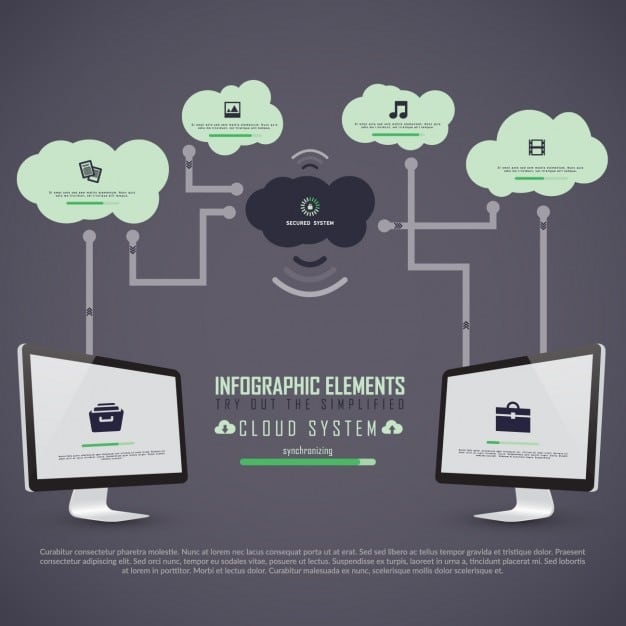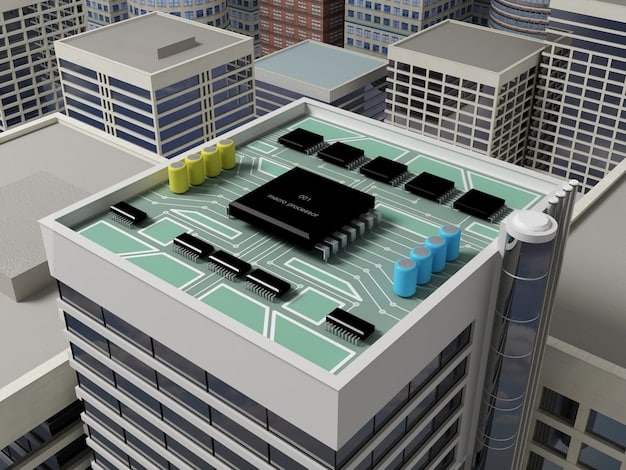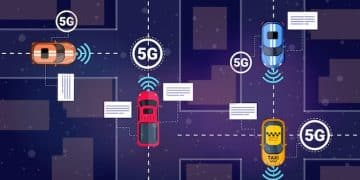Edge Computing: Transforming US Businesses with Faster Data Processing

Edge computing empowers US businesses by processing data closer to the source, reducing latency, improving efficiency, and enabling real-time decision-making for various applications.
In today’s rapidly evolving technological landscape, businesses are constantly seeking ways to gain a competitive edge. Edge computing: How US Businesses Can Benefit from Faster Data Processing emerges as a transformative approach, bringing computation and data storage closer to the source of data, thereby revolutionizing various industries and offering unparalleled advantages.
Understanding Edge Computing and Its Relevance to US Businesses
Edge computing represents a paradigm shift in how data is processed and managed. Instead of relying solely on centralized data centers, edge computing distributes processing power to the “edge” of the network, closer to where data is generated.
This proximity brings several key benefits to US businesses, improving operations across various sectors.
What is Edge Computing?
Edge computing fundamentally alters the traditional data processing model. Instead of transmitting all data to a central cloud server for processing, edge computing brings the computational resources closer to the data source.
This can be achieved through various means, such as deploying micro data centers, utilizing edge servers, or leveraging smart devices with onboard processing capabilities.
Why is Edge Computing Important for US Businesses?
Edge computing offers a compelling value proposition for US businesses looking to optimize operations, enhance customer experiences, and drive innovation. Its increasing importance is driven by several factors:
- Reduced Latency: By processing data closer to the source, edge computing minimizes latency, enabling real-time applications and faster response times.
- Increased Bandwidth Efficiency: Only essential data is transmitted to the cloud, reducing bandwidth consumption and network congestion.
- Enhanced Security: Data can be processed and stored locally, minimizing the risk of data breaches and improving compliance with data privacy regulations.
- Improved Reliability: Edge computing enables continuous operation even when network connectivity is intermittent or unavailable.

In conclusion, edge computing provides US businesses with a multitude of benefits by decentralizing data processing, decreasing latency, and improving overall operational efficiency.
Key Benefits of Edge Computing for US Businesses
The advantages of edge computing span across various aspects of business operations, offering considerable improvements in efficiency, agility, and innovation potential. Let’s explore some of the most significant benefits.
By understanding these advantages, US businesses can leverage them to drive their technological advancement.
Faster Data Processing and Reduced Latency
One of the most significant advantages of edge computing is its ability to accelerate data processing. By bringing computational capabilities closer to the data source, latency is drastically reduced.
This is particularly crucial for applications that require real-time responses, such as:
- Autonomous Vehicles: Processing sensor data locally enables quick decision-making, enhancing safety and navigation.
- Industrial Automation: Real-time monitoring and control of machinery increase efficiency and reduce downtime.
- Augmented Reality (AR): Low latency ensures seamless and immersive AR experiences for users.
Improved Bandwidth Utilization and Cost Savings
Traditional cloud computing models often require transferring massive amounts of data to centralized servers, straining network bandwidth and incurring significant costs. Edge computing addresses these challenges by processing data locally.
By filtering and processing data at the edge, only relevant information is transmitted to the cloud, reducing bandwidth consumption and associated costs.
Enhanced Security and Data Privacy
Data security and privacy are paramount concerns for US businesses. Edge computing offers enhanced security by processing data locally, reducing the risk of data breaches and unauthorized access.
This approach aligns with data privacy regulations, such as:
- HIPAA (Health Insurance Portability and Accountability Act): Protecting sensitive patient information in healthcare.
- CCPA (California Consumer Privacy Act): Providing consumers with greater control over their personal data
- GDPR (General Data Protection Regulation): Ensuring compliance with global data protection standards.
Summarizing, edge computing significantly benefits US businesses by enhancing data processing speeds, optimizing bandwidth use, cutting costs, and strengthening data security and privacy measures.
Edge Computing Applications Across Industries in the US
The versatility of edge computing makes it a valuable asset across a wide range of industries in the US. From healthcare to manufacturing, the applications are diverse and impactful.
Below are a few key industries that are benefitting from edge computing.
Healthcare
In healthcare, edge computing enables real-time monitoring of patients, remote diagnostics, and personalized treatment plans. Wearable devices can collect vital signs and transmit data to edge servers for immediate analysis.
This ensures timely interventions and improved patient outcomes. Furthermore, secure edge devices can maintain patient data privacy while providing necessary medical insights.
Manufacturing
Edge computing is revolutionizing manufacturing by enabling predictive maintenance, real-time quality control, and optimized production processes. Sensors on machinery can collect data that is processed at the edge to detect anomalies and predict potential failures.
This proactive approach reduces downtime, increases efficiency, and improves product quality. Additionally, edge computing supports the integration of IoT devices in smart factories, improving overall operational agility.
Retail
Edge computing is transforming the retail industry by enhancing customer experiences, optimizing inventory management, and improving operational efficiency. Edge servers in retail stores can process data from surveillance cameras and sensors to monitor customer behavior and optimize store layouts.
This leads to better product placement, personalized promotions, and reduced theft. Moreover, edge computing supports real-time inventory tracking, ensuring that products are always available when customers need them.

In conclusion, edge computing’s adaptability transforms various sectors like healthcare, manufacturing, and retail by enabling real-time processing, enhancing security, and optimizing operations.
Implementing Edge Computing: Challenges and Considerations
While the benefits of edge computing are undeniable, implementing it effectively requires careful planning and consideration of various challenges. Understanding these challenges is crucial for successful deployment.
Here are some key aspects to consider when integrating edge computing.
Security Concerns
Distributing data processing to the edge increases the attack surface and introduces new security vulnerabilities. Securing edge devices and ensuring data privacy are critical concerns.
Implementing robust authentication mechanisms, encryption protocols, and intrusion detection systems is essential to mitigate these risks.
Infrastructure Complexity
Managing a distributed edge infrastructure can be complex. Monitoring, maintaining, and updating numerous edge devices require sophisticated management tools and processes.
Businesses need to invest in solutions that provide centralized visibility and control over their edge deployments.
Connectivity Requirements
Reliable network connectivity is essential for edge computing to function effectively. Intermittent or unstable connections can disrupt data processing and impact application performance.
Businesses need to ensure that their edge locations have robust network infrastructure and backup connectivity options.
- Evaluate the Current Infrastructure: Assess existing network capabilities and identify areas that need improvement.
- Consider Data Governance: Implement policies to manage data flow and ensure compliance with regulatory requirements.
- Prioritize Security: Implement robust security measures to protect edge devices and data.
Ultimately, addressing security issues, managing infrastructure complexity, ensuring reliable connectivity, and careful planning are critical for US businesses to effectively deploy edge computing solutions.
Future Trends in Edge Computing
Edge computing is a rapidly evolving field, with numerous trends shaping its future trajectory. Keeping abreast of these trends is essential for US businesses to stay competitive and innovative.
Here are some key trends that are poised to drive the advancement of edge computing.
Artificial Intelligence (AI) at the Edge
Integrating AI and machine learning capabilities at the edge enables real-time analysis and decision-making. Edge AI applications include:
- Predictive Maintenance: Analyzing sensor data to predict equipment failures.
- Autonomous Systems: Enabling robots and drones to operate independently.
- Smart Surveillance: Detecting anomalies and threats in real-time.
5G and Edge Computing Convergence
The combination of 5G and edge computing provides ultra-fast connectivity and low latency, enabling new applications and services. 5G networks support the massive bandwidth requirements of edge computing, facilitating seamless data transfer and real-time communication.
This convergence opens up opportunities for applications such as:
- Remote Healthcare: Enabling remote monitoring and telehealth services.
- Smart Manufacturing: Supporting real-time control and optimization of production processes.
- Connected Vehicles: Facilitating vehicle-to-vehicle and vehicle-to-infrastructure communication.
Edge Computing as a Service (ECaaS)
Edge Computing as a Service (ECaaS) is emerging as a viable option to simplify edge deployments. ECaaS provides businesses with access to pre-built edge infrastructure and services, reducing the complexity and cost of managing edge deployments.
This model enables businesses to focus on developing and deploying applications without worrying about the underlying infrastructure.
In summary, future trends in edge computing emphasize integrating AI, leveraging 5G, and utilizing ECaaS to improve data processing speeds, lower latency, and create new business opportunities.
Getting Started with Edge Computing: A Practical Guide for US Businesses
To successfully implement edge computing, US businesses need a structured approach that considers their specific needs and goals. This practical guide outlines the key steps to get started.
Here is how US businesses can practically integrate edge computing into their operations.
Assess Your Needs and Goals
The first step is to identify the business challenges that edge computing can address. Determine the specific applications and use cases that can benefit from faster data processing and reduced latency.
Define the key performance indicators (KPIs) that will be used to measure the success of the edge deployment.
Choose the Right Edge Computing Platform
Select an edge computing platform that aligns with your needs and budget. Consider factors such as:
- Scalability: The ability to scale the edge infrastructure as your needs grow.
- Security: Robust security features to protect edge devices and data.
- Management Tools: User-friendly tools for monitoring and managing edge deployments.
Develop a Deployment Strategy
Create a detailed deployment plan that outlines the technical architecture, hardware requirements, and software components. Consider the location of edge devices and the network infrastructure needed to support them.
Implement a phased approach, starting with a pilot project to test and refine the edge deployment strategy. Additionally, provide ongoing training and support to ensure the successful adoption of edge computing.
| Key Aspect | Brief Description |
|---|---|
| 🚀 Reduced Latency | Processes data closer to the source, enabling real-time applications in IoT and automation. |
| 🛡️ Enhanced Security | Processes data locally, reducing the risk of data breaches and ensuring compliance with data privacy regulations. |
| 💰 Improved Cost Efficiency | Optimizes bandwidth usage by processing data at the edge, reducing data transfer costs to the cloud. |
| 🏭 Industrial Applications | Enables predictive maintenance, quality control, and optimized production in manufacturing through real-time data analysis. |
Frequently Asked Questions
▼
The primary advantage is reduced latency by processing data closer to the source, enabling real-time applications and faster responses.
▼
Edge computing enhances security by processing data locally, decreasing the risk of breaches and ensuring compliance with privacy regulations.
▼
Healthcare, manufacturing, and retail are industries that see major operational and service improvements using edge computing solutions.
▼
Expect continued integration of AI, widespread 5G adoption, and growing availability of Edge Computing as a Service (ECaaS) solutions.
▼
Start by assessing business goals, choose the right platform, and develop a well-planned deployment strategy while prioritizing security.
Conclusion
In conclusion, edge computing offers US businesses immense opportunities to transform their operations by reducing latency, enhancing security, and enabling real-time applications. By understanding the benefits, challenges, and future trends, businesses can leverage edge computing to drive innovation and gain a competitive advantage in today’s digital economy.





